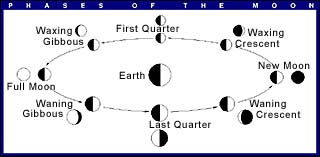The Moon's Phases

The lunar month is the 29.53 days it takes to go from one new moon to the next. During the lunar month, the Moon goes through all its phases. You can see the phases drawn in the image below. Just like the Earth, half of the Moon is lit by the Sun while the other half is in darkness. The phases we see result from the angle the Moon makes with the Sun as viewed from Earth.
At new moon, the Moon is lined up between the Earth and the Sun. We see the side of the Moon that is not being lit by the Sun (in other words, we see no Moon at all, because the brightness of the Sun outshines the dim Moon!) When the Moon is exactly lined up with the Sun (as viewed from Earth), we experience an eclipse.
As the Moon moves eastward away from the Sun in the sky, we see a bit more of the sunlit side of the Moon each night. A few days after new moon, we see a thin crescent in the western evening sky. The crescent Moon waxes, or appears to grow fatter, each night. When half of the Moon's disc is illuminated, we call it the first quarter moon. This name comes from the fact that the Moon is now one-quarter of the way through the lunar month. From Earth, we are now looking at the sunlit side of the Moon from off to the side.
The Moon continues to wax. Once more than half of the disc is illuminated, it has a shape we call gibbous. The gibbous moon appears to grow fatter each night until we see the full sunlit face of the Moon. We call this phase the full moon. It rises almost exactly as the Sun sets and sets just as the Sun rises the next day. The Moon has now completed one half of the lunar month.
During the second half of the lunar month, the Moon grows thinner each night. We call this waning. Its shape is still gibbous at this point, but grows a little thinner each night. As it reaches the three-quarter point in its month, the Moon once again shows us one side of its disc illuminated and the other side in darkness. However, the side that we saw dark at the first quarter phase is now the lit side. As it completes its journey and approaches new moon again, the Moon is a waning crescent.
 |
